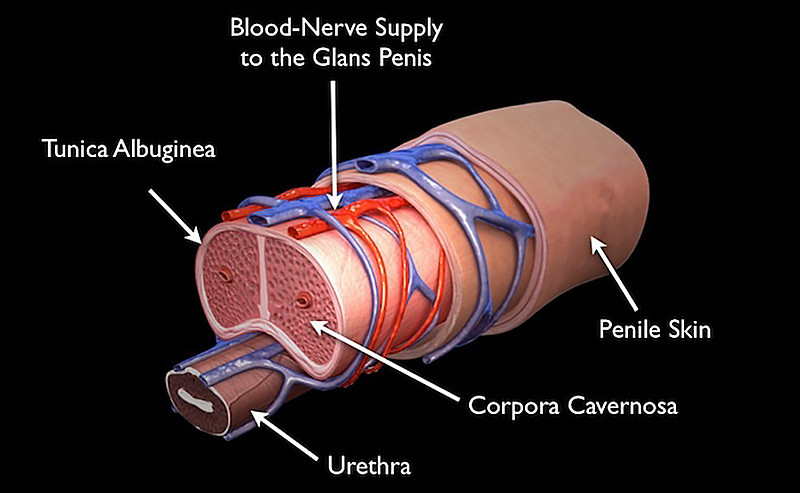The function of the penis is to provide a means of urination and sexual function. The penis contains the penile urethra that is a tube that transports urine and semen out the tip of the penis. In addition, the penis functions by filling with blood during an erection to enable penetrative sexual intercourse. This section will focus on penis function related to erections.
The illustration shows a cross section of the shaft of the penis. The first layer is the skin. Under the skin is very thin flimsy tissue that provides blood supply to the skin. Just under that, especially towards the top of the penis, there are important arteries and veins and nerves that provide blood flow to the head of the penis and sensitivity. This is called the neurovascular bundle. Along the bottom of the penis, under the skin, is the penile urethra.
When we get deep to these neurovascular structures, there is a fairly firm structure that is called the tunica albuginea. This is what is mostly felt under the skin and makes up the bulk of the length and girth of the penis.
The tunica albuginea of the penis is a structure similar to a balloon in some ways. When a balloon is relatively empty, it is soft and floppy. When filled with water, it becomes longer, wider and more rigid. The penis is not made of rubber. However, like rubber, the tunica albuginea can stretch and become more rigid when the penis fills with blood. Within the tunica albuginea is sponge-like vascular tissue.

Illustration of the anatomy of the penis. During an erection, blood enters the corpora cavernosa.
During an erection, more blood enters this sponge like space, causing the tunica albuginea to expand, and the penis to become longer, wider, and more rigid. Like all structures in the body, arteries bring blood (and oxygen) to the penis, and veins take the blood away. The penis, when flaccid (not hard) has blood inflow and blood outflow – blood entering the penis through arteries and leaving the penis through veins. During an erection, the blood enters the penis faster and the veins pinch off (occlude) causing the tunica albuginea to expand. In a way, the function of a penis is like a sink with a faucet and drain. The faucet is always on (not full force) and the drain is open. An erection is in a way like turning up the flow from the faucet and plugging the drain. In simple terms to explain penis function, an erection happens because the brain tells nerves to release a substance in the penis. That substance then causes sponge-like tissue of the tunica albuginea to change in a way that leads to more blood entering the penis and less blood leaving the penis, causing an erection.
Although a main function of the penile urethra is to transport urine and semen, the urethra is surrounded by vascular sponge like tissue (called corpus spongiosum) and this spongy vascular tissue also expands during an erection. In addition, as the penile urethra and associated corpus spongiosum approach the tip of the penis, this tissue “mushrooms” to become the head of the penis (glans penis). The head of the penis is essentially and expansion of this sponge like bloody vascular tissue, and as the shaft of the penis becomes erect, so does the head of the penis.

